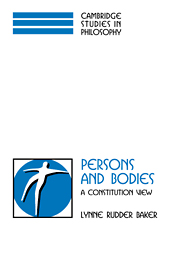2 - The Very Idea of Constitution
Published online by Cambridge University Press: 05 June 2012
Summary
The relation between a person and his or her body, I shall argue, is simply an instance of a very general relation: constitution. Constitution is a fundamental relation that is ubiquitous. It is the relation that obtains between an octagonal piece of metal and a Stop sign, between strands of DNA molecules and genes, between pieces of paper and dollar bills, between stones and monument; between lumps of clay and statues — the list is endless. So, apart from the light that it sheds on human persons, the idea of constitution holds philosophical interest in its own right. In this chapter, I shall give a very general and technical account of this important idea.
There are additional reasons to be explicit about the idea of constitution. First, as I have argued elsewhere, I think that constitution cannot be understood as identity. But if constitution is not identity, what exactly is it? In this chapter, I am going to try to say. Constitution has been caricatured by those who cannot imagine a relation of unity that is intermediate between identity and separate existence. The idea of such an intermediate position strikes many philosophers as incoherent. Nothing but a detailed exposition of the idea of constitution will absolve it of the charge of incoherence or obscurity. Second, I start with assumptionsthat are different from those of other writers on constitution. Philosophers typically treat constitution as a matter of relations between things and their parts.
- Type
- Chapter
- Information
- Persons and BodiesA Constitution View, pp. 27 - 58Publisher: Cambridge University PressPrint publication year: 2000



